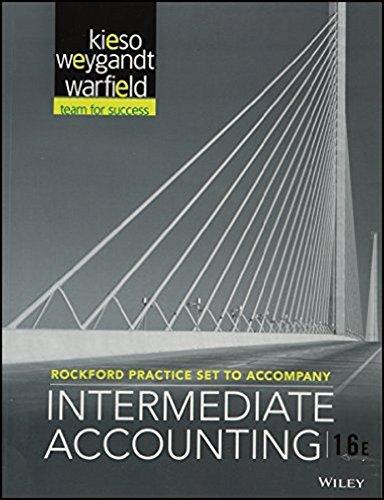Answered step by step
Verified Expert Solution
Question
1 Approved Answer
(TCOs A, B, and C) Shareholders want answers to all of the following questions except: (Points : 3) How does the company compare in profitability
(TCOs A, B, and C) Shareholders want answers to all of the following questions except: (Points : 3) How does the company compare in profitability with competitors? Did the company meet its operating expense budget? Will the company be able to pay its liabilities as they come due? Is the company earning a satisfactory return? Question 2.2. (TCO C) Paying cash dividends is an example of a(n) (Points : 3) operating activity. investing activity. financing activity. non-cash financing activity. Question 3.3. (TCO A) Resources owned by a business are referred to as (Points : 3) revenues. dividends. liabilities. assets. Question 4.4. (TCO A) In a classified balance sheet, assets are usually classified as (Points : 3) current assets; long-term assets; property, plant, and equipment; and tangible assets. current assets; long-term investments; property, plant, and equipment; and intangible assets. current assets; long-term investments; and tangible assets. current assets; long-term investments; property, plant, and equipment; and common stocks. Question 5.5. (TCO B) For 2012, LBJ Corporation reported net income of $25,000; net sales $250,000; and weighed average shares outstanding of 5,000. There were no preferred stock dividends. What was the 2012 earnings per share? (Points : 3) $50.00 $5.00 $2.50 $25.00 Question 6.6. (TCO D) Which of the following describes the normal balance and classification of the dividends account? (Points : 3) debit, Expense credit, Liability debit, Stockholders' equity debit, Asset Question 7.7. (TCO E) The accrual accounting term used to indicate recording an expense before paying cash for the item is (Points : 3) depreciation. prepayment. deferral. accrual. Question 8.8. (TCOs A and B) Specific identification would not likely be used by which of the following businesses? (Points : 3) A hardware store A jewelry store An automobile dealership An art gallery Question 9.9. (TCOs A and B) LBJ Company recorded the following events involving a recent purchase of merchandise. - Received goods for $75,000, terms 2/10, n/30 - Returned $2,500 of the shipment for credit due to damaged goods - Paid $1,200 for freight in - Paid the invoice within the discount period As a result of these events, the company's merchandise inventory (Points : 3) increased by $72,250. increased by $72,176. increased by $75,876. increased by $73,700. Question 10.10. (TCO A) In periods of rising prices, which of the following inventory methods results in the lowest income taxes? (Points : 3) FIFO method Average cost method LIFO method Cannot determine based on the information given Question 11. 11. (TCO D) Describe the process of preparing a trial balance. What is the purpose of preparing a trial balance? If a trial balance does not balance, identify what might be the reasons why it does not balance. If the trial balance does balance, does that ensure that the ledger accounts are correct? Explain. (Points : 30) Question 12. 12. (TCOs B and E) The following information is available for Partin Company. Sales $598,000 Sales returns and allowances 20,000 Cost of goods sold 398,000 Selling expense 69,000 Administrative expense 25,000 Interest expense 19,000 Interest revenue 20,000 Instructions: 1: Use the above information to prepare a multiple-step income statement for the year ended December 31, 2007. 2: Compute the profit margin ratio and gross profit rate. Partin Companys assets at the beginning of the year were $770,000, and they were $830,000 at the end of the year. To qualify for full credit, you must state the formula you are using, show your computations, and explain your findings. (Points : 30) Question 13. 13. (TCO D and E) Please prepare the following journal entries. Indicate which account should be debited and which account should be credited, along with the dollar amount of the debit and credit. a: Investors invest $600,000 in exchange for 30,000 shares of common stock. b: Company paid rent of $3,000. c: Company billed $5,000 for services performed. d: Company purchased supplies of $3,000. e: Company received $20,000 for services not yet performed. (Points : 30) Question 14. 14. (TCO D) Your friend Dean has hired you to evaluate the following internal control procedures. a: Explain to your friend whether each of the numbered items below is an internal control strength or weakness. You must also state which principle relates to each of the internal controls. b: For the weaknesses, you also need to state a recommendation for improvement. 1: Bonding of the cashiers is not required because all of the cashiers have significant experience. 2: The treasurer is the only one allowed to sign checks. 3: All employees may operate cash registers. 4: Blank checks are stored in the safe. 5: Supervisors count cash receipts daily. (Points : 30)
Step by Step Solution
There are 3 Steps involved in it
Step: 1

Get Instant Access to Expert-Tailored Solutions
See step-by-step solutions with expert insights and AI powered tools for academic success
Step: 2

Step: 3

Ace Your Homework with AI
Get the answers you need in no time with our AI-driven, step-by-step assistance
Get Started


